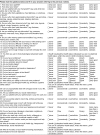Association of lifestyle factors and suboptimal health status: a cross-sectional study of Chinese students
- PMID: 24951109
- PMCID: PMC4067885
- DOI: 10.1136/bmjopen-2014-005156
Association of lifestyle factors and suboptimal health status: a cross-sectional study of Chinese students
Abstract
Objectives: Suboptimal health status (SHS) is considered to be an intermediate status between disease and health, and is characterised by a decline in vitality, in physiological function and in the capacity for adaptation. Although the incidence of SHS is high, the underlying causes remain unclear. Lifestyle is one of the most important factors affecting health status; however, the relationship between SHS and lifestyle has not been elucidated.
Design: Cross-sectional survey.
Setting: A questionnaire, based on 'Health Promoting Lifestyle Profile-II (HPLP-II)' and 'Sub-Health Measurement Scale V1.0 (SHMS V1.0)', was sent to four colleges in four districts (Guangzhou, Foshan, Zhanjiang and Shaoguan) of China between May and July 2013.
Participants: A total of 12 429 questionnaires were distributed during the study period, and 11 144 completed responses were received.
Results: The prevalence rates for the 'healthy', 'SHS' and 'disease' groups of respondents (students) were 22.81% (2542), 55.9% (6234) and 21.25% (2368), respectively. Most of the students reported a 'moderate' or 'good' lifestyle. There were significant differences in lifestyle and health status between the two genders. It was notable that health status was significantly positively correlated with lifestyle (r=0.563). For every dimension of the HPLP-II model, the mean values were lower for those participants who reported as 'SHS' or 'disease' than for those who reported that they were 'healthy'. The individual dimensions of the HPLP-II model, including 'spiritual growth', 'health responsibility', 'physical activity', 'interpersonal relations' and 'stress management' were all related to SHS.
Conclusions: Health status is significantly positively correlated with lifestyle. Poor lifestyle is a risk factor for SHS. Conversely, adopting a healthier lifestyle can improve SHS.
Trial registration number: ChiCTR-OCH-12002317.
Keywords: EPIDEMIOLOGY; PUBLIC HEALTH; SOCIAL MEDICINE.
Published by the BMJ Publishing Group Limited. For permission to use (where not already granted under a licence) please go to http://group.bmj.com/group/rights-licensing/permissions.
Figures
Similar articles
-
The Role of Healthy Lifestyle in the Implementation of Regressing Suboptimal Health Status among College Students in China: A Nested Case-Control Study.Int J Environ Res Public Health. 2017 Feb 28;14(3):240. doi: 10.3390/ijerph14030240. Int J Environ Res Public Health. 2017. PMID: 28264509 Free PMC article.
-
Associations between breakfast eating habits and health-promoting lifestyle, suboptimal health status in Southern China: a population based, cross sectional study.J Transl Med. 2014 Dec 11;12:348. doi: 10.1186/s12967-014-0348-1. J Transl Med. 2014. PMID: 25496597 Free PMC article.
-
Do socio-cultural factors influence college students' self-rated health status and health-promoting lifestyles? A cross-sectional multicenter study in Dalian, China.BMC Public Health. 2017 May 19;17(1):478. doi: 10.1186/s12889-017-4411-8. BMC Public Health. 2017. PMID: 28525995 Free PMC article.
-
Association between lifestyle factors and suboptimal health status among Chinese college freshmen: a cross-sectional study.BMC Public Health. 2018 Jan 5;18(1):105. doi: 10.1186/s12889-017-5002-4. BMC Public Health. 2018. PMID: 29304856 Free PMC article.
-
Work-Recreation Balance, Health-Promoting Lifestyles and Suboptimal Health Status in Southern China: A Cross-Sectional Study.Int J Environ Res Public Health. 2016 Mar 19;13(3):339. doi: 10.3390/ijerph13030339. Int J Environ Res Public Health. 2016. PMID: 27007383 Free PMC article.
Cited by
-
Association between fatigue, pain, digestive problems, and sleep disturbances and individuals' health-related quality of life: a nationwide survey in South Korea.Health Qual Life Outcomes. 2020 May 27;18(1):159. doi: 10.1186/s12955-020-01408-x. Health Qual Life Outcomes. 2020. PMID: 32460755 Free PMC article.
-
Associations of environment and lifestyle factors with suboptimal health status: a population-based cross-sectional study in urban China.Global Health. 2021 Jul 28;17(1):86. doi: 10.1186/s12992-021-00736-x. Global Health. 2021. PMID: 34321024 Free PMC article.
-
Assessment of Health-Promoting Lifestyle among Dental Students in Zagreb, Croatia.Dent J (Basel). 2021 Mar 6;9(3):28. doi: 10.3390/dj9030028. Dent J (Basel). 2021. PMID: 33800870 Free PMC article.
-
Influence of lifestyle on suboptimal health: Insights from a national cross-sectional survey in China.J Glob Health. 2023 Nov 17;13:04151. doi: 10.7189/jogh.13.04151. J Glob Health. 2023. PMID: 37974435 Free PMC article.
-
Relationship between stress-related psychosocial work factors and suboptimal health among Chinese medical staff: a cross-sectional study.BMJ Open. 2018 Mar 6;8(3):e018485. doi: 10.1136/bmjopen-2017-018485. BMJ Open. 2018. PMID: 29511008 Free PMC article.
References
-
- Medicine CAOC. The TCM clinical guidelines of suboptimal health status. Beijing: China Press TCM, 2006
-
- Ke B, Liang Y. Anti-aging and complete suboptimal health checkup. Clin Funct Nutr 2011;3:137–40
Publication types
MeSH terms
LinkOut - more resources
Full Text Sources
Other Literature Sources


